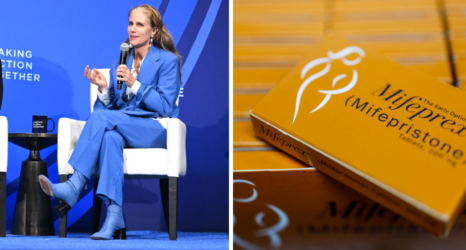Back to school time is the perfect opportunity to take boards of education to school over sex education.

It’s back to school time and youth across the country are preparing for a new year of science, English and math classes. But there’s another course that’s fundamental to a young person’s growth and development that many students are missing out on: comprehensive sex education.
It’s been a long time since I was a student—nearly 35 years—but until recently, I didn’t have any recollection about receiving sex education in the small Nebraska town where I grew up in the 1980s. During COVID lockdown, however, I was sifting through old papers and found my eighth grade sex education course outline. According to the mimeographed papers, the five-hour course covered anatomy, pregnancy and parenthood after marriage. As far as I know, this was the only sex education I received from kindergarten through college.
I’m a family planning counselor, so finding those old sex ed documents piqued my interest and inspired me to search for more information about the type of sex education I received back then and how my hometown is handling sex education now.
Sex Ed Then and Now
If you’re one of the lucky people who had comprehensive sex education at school, you may think it’s the norm—but it’s not. Sex education is largely decided on the state level, and local implementation varies wildly. Only 30 states and the District of Columbia mandate sex education at all—with no guarantee that it is medically accurate, age-appropriate or unbiased.
An online search of my own school district revealed that not much has changed in the 35 years since my sex education experience. I was lucky enough to stumble upon a student-written article published in 2020, “Let’s Talk About Sex,” that explained that even today, sex education in Nebraska is left up to each school district. Because comprehensive sex education isn’t required, that often leaves students in the dark when it comes to consent, gender identity, sex-positive messages, abortion and so much more.
Despite all the strides in understanding gender, sex and teen pregnancy, students today receive a sex education very similar to one I was taught 35 years ago.
The author of that article, Syd Cole, was a student at the same high school I attended. They explained that my district, then and now, taught an abstinence-plus sex education curriculum that includes information on condoms and contraception, but stresses abstinence.
Abstinence-only-until-marriage programs (also referred to as “sexual risk avoidance”) have been proven ineffective at their primary goal of getting young people to delay sex until marriage. Yet they’re still taught today.
In contrast, comprehensive sex education has been shown to lower the risk of teen pregnancy by 50 percent, delay the initiation of sex, reduce the number of sexual partners and decrease the incidence of unprotected sex.
Cole’s article revealed a few minor but positive changes in my former school district over the years. Students today learn about contraception and sexually transmitted diseases one year earlier than they did when I attended school—in seventh grade instead of eighth. And, thankfully, people now learn about the female reproductive system and the menstrual cycle in fourth grade and about the male anatomy in fifth grade.
While these are important improvements, it is troubling that despite all the strides in understanding gender, sex and teen pregnancy, students today receive a sex education very similar to one I was taught 35 years ago. In fact, in Nebraska, the public school sex education curriculum has not received a large-scale update since it was introduced in 1986.
Meanwhile, in the intervening years we embraced the internet and invented smart phones, legalized gay marriage, and began to come to grips with the enormity of climate change, even as social justice issues like Black Lives Matter and #MeToo took hold. Sex education must evolve alongside everything else.
The Need for Sex Ed Curriculum Updates
Back to school time is the perfect opportunity to take boards of education to school over sex education. Reproductive health, rights and justice allies are calling for the need to modernize how sex education is delivered in the United States. Age-appropriate comprehensive sexual education is important for everyone regardless of race, gender, ability, income or where they live.
Comprehensive sex education does even more to support young people than just giving them the tools to make responsible decisions about sex. It has been shown to prevent child sex abuse, increase healthy relationships and media literacy, and dismantle social and racial justice barriers by promoting equity and inclusion in school. We need to advocate for medically accurate, LGBTQ+ inclusive and culturally responsive sex education.
One great way to do that on the national level is to support the Real Education and Access for Healthy Youth Act (REAHYA), which was introduced this summer by Reps. Barbara Lee (D-Calif.) and Alma Adams (D-N.C.) in the House and Sens. Cory Booker (D-N.J.) and Mazie Hirono (D-Hawaii) in the Senate.
This legislation would ensure that all young people—particularly those living in rural settings, communities of color, LGBTQ+ youth, immigrants, youth with lower incomes, youth with disabilities and youth in care—are equipped with the education, information and skills they need to make informed decisions for themselves about sex and relationships. Everyone deserves age-appropriate, medically accurate information and answers to their questions about sex and relationships, free of shame and stigma.
Unfortunately, the sex ed experience I had nearly four decades ago was not unique then and it’s not unique now. This school year, let’s take the time to advocate for medically accurate, LGBTQ+ inclusive and culturally responsive comprehensive sex education to improve the lives of children and parents, dispel myths about sex, prevent unplanned pregnancies and even help protect the environment. It’s past time to make it available to students everywhere.
Up next:












